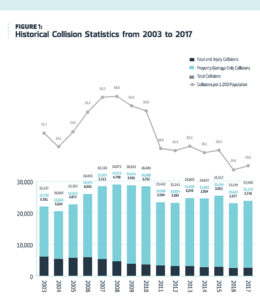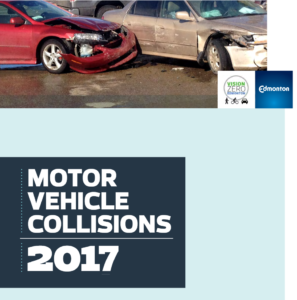
Edmonton Collisions and crashes: 2017 edition
Drivers deserve road safety too

The annual look at Edmonton’s traffic deaths and injuries is always a mix of good news and bad.
The good news from last year is a reduction in the number of collisions involving more vulnerable road users; people walking, biking and riding motorcycles. The bad news is that there were more collisions in total and more people killed, with the increases far outpacing our population growth (and we even saw a decrease in the number of passenger vehicles on the road). More people outside of vehicles were also killed, 14 to 13.
While the news release touts how it’s important to remember road safety on a busy holiday weekend, Friday afternoon is renowned as the time to release news you don’t really want a lot of media pick-up on. Love that long weekend spin though!
As mentioned, the 2017 stats show safety improvements for people walking and cycling in Edmonton. While it’s tough to pull definitive conclusions from a single year of data, there could be lessons learned from what happened last year.
There’s obviously been an increase in pressure to improve the safety for people walking and cycling. We have new bike lanes downtown, to its west and south of the river in and around Old Strathcona. That works continues to increase with the 83 Avenue bike route to be completed this year and the 106-76 lanes to be extended from Queen Alexandra. We’ll also see a southside grid properly connect all of these routes, the U of A and downtown. We also see more and better sidewalk connections being built through neighbourhood renewal efforts and we’re getting better at pedestrian-first thinking, like covering a sidewalk at construction sites instead of closing it and forcing people walking into the street.
It’s still piecemeal, but the advocacy may be paying off. I’d add that more people driving are probably hearing these kinds of messages about walking and cycling safety and paying even a little bit more attention in some places.
Inside vehicles, however, we see things getting worse between 2016 and 2017. The biggest reason may be driver distraction, with plenty of people still using their phones behind the wheel (among other things that can distract your attention from the road).
A surprisingly popular chart, now updated for 2017!
What do #yeg drivers hit?
And what can we blame jay-walkers for this time?#yegtraffic #yegwalk #yegbike #visionzero pic.twitter.com/16J2z28t4n— chris – sᴉɹɥɔ (@newfangl3d) May 19, 2018
I might add a flip-side to the walking and cycling advocacy to this trend too. We see very much the opposite kind of pressure politically when it comes to driving.
Our city’s two largest newspapers, which still carry a lot of the regular urban affairs discussion on larger platforms, are good examples of this, often touting a non-existent war on cars, how terrible LRT or mass transit could be (particularly for our taxes), how photo radar is some kind of cash cow, how testing out speed reductions in busy neighbourhoods is just awful and any myriad of other topics related to transportation. They double-down on the notion that Edmonton is a city built for driving, usually as fast as possible, and anything that changes that is somehow an affront to our livelihood.
It’s this kind of messaging across all Edmonton media which whips up frenzy on platforms like Twitter and Facebook/comment sections about leftist machinations to replace your pick-up truck with a hipster bicycle built-for-two. It also seeps into the political decision-making at city hall, where councillors refuse to fix dangerous crosswalks, waffle on reduced speeds near playgrounds and schools, and delay talking about speed limit reductions on neighbourhood streets. Local news still carries a lot of weight at city hall, especially when councillors are trying to gauge how much hate mail they’ll get over a decision.
So they don’t make any decision. Or they delay and alter safety changes to appease a loud opposition that sounds larger than it is. Even if that will kill people.
We’re going to see continued pressure to improve the safety of people walking and cycling in Edmonton, so it’s time for drivers to find their voice too (as we like to promote around here, you can let your city councillor know what you think). Everyone deserves to be safe while traveling around Edmonton, including people driving. Drivers should join the call for 30 km/h speed limits in neighbourhoods and re-designing roads to reduce speeds, improve sight lines and increase reaction time, helping to reduce their deaths just the same as people walking and cycling. We all deserve to get where we’re going safely.
I included one tweet from @newfangled‘s regular Vision Zero safety guides, but there are many more worth checking out for sarcastic safety tips (pulled from actual traffic collision data).
If you enjoyed this story, and want to see more like it, consider supporting us.
Support EQ
